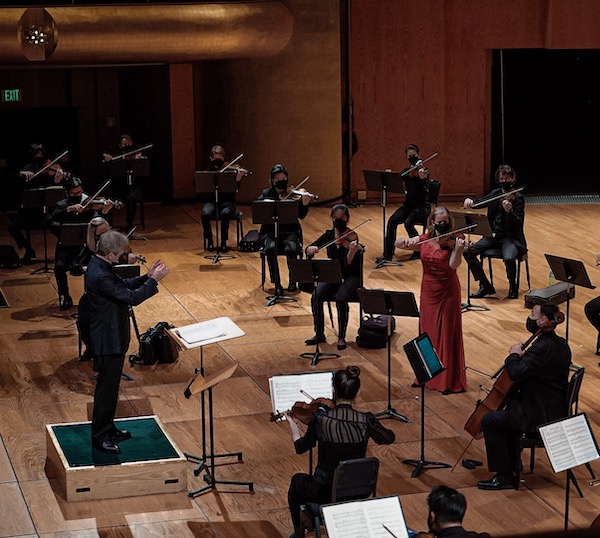Thierry Fischer returns with a smart and stylish Utah Symphony program

The music of Arnold Schoenberg, his students Anton Webern and Alban Berg, and a slew of disciples in academia can still confound audience members after a century.
Credited with the invention of “atonal” music, the Second Viennese School is regarded by some as an unfortunate glitch in the musical space-time continuum. Yet by placing Schoenberg on the same Utah Symphony program as Haydn—his counterpart in the posthumously named First Viennese School— Thierry Fischer made the case for seeing the Second Viennese School as part of classical music’s logical progression.
Thursday night’s concert at Abravanel Hall also marked the return of the orchestra’s music director to the podium after a series of guest conductors. The program featured concertmaster Madeline Adkins as soloist in Ralph Vaughan Williams’ tone poem The Lark Ascending, the evening’s centerpiece between Haydn’s Symphony No. 30 and Schoenberg’s Chamber Symphony No. 1.
Haydn’s Symphony No. 30 was nicknamed the “Alleluia Symphony” due to its quotation of a plainchant Alleluia that would have been familiar to listener’s of Haydn’s day. In contrast to the more fiery and emotional works of his ensuing Sturm und Drang period, Haydn’s Symphony No. 30 stands as a prime example of the Classical balance and scale that typifies his early-period works in the genre.
Fischer’s nuanced, refined interpretation of the Haydn showcased the orchestra’s polish and dynamic range. In the first movement’s witty Allegro, he dug into the short phrases and the orchestra responded with crisp articulation. Fischer and the orchestra also gave shape to the whole movement, with muted anticipatory passages growing to a triumphant climax.
In the Andante, principal Mercedes Smith played her flute solo with soulful panache. Fischer and the orchestra gave the final movement—a lively Minuet—a distinct character, the chamber orchestra leaning into the rollicking rhythm. Throughout the performance, Jason Hardink’s well-balanced harpsichord reminded the audience that we were firmly in music of the 18th century.
The Lark Ascending proved a perfect vehicle for Madeline Adkins. Based on a poem by George Meredith, the tone poem casts the solo violin as a lark—at first trying its wings, and then soaring over England’s green countryside. With open fifths and thickly stacked extended harmonies, The Lark Ascending evokes England’s farms and fields in its pastoral nostalgia for a lost, idyllic past.
The work begins with a mini cadenza, which showcased Adkins’ effortless virtuosity. Throughout the piece, her interpretative gifts were wholly in the service of the musical narrative. The orchestra produced a rich, full sound over which her violin soared. The piece ends as it begins, with an extended solo and Adkins’s gradual decrescendo so held the audience’s attention that they set spellbound for several seconds after the music had faded to silence.
There is nothing pastoral or nostalgic about Schoenberg’s boisterous Chamber Symphony No. 1. Written in 1906, eight years before The Lark Ascending, it is pointed toward the future with a 12-tone modernism that wold reign for the next six decades of the 20th century.
Written for 15 players and including such exotic instrumentation as bass clarinet and bass bassoon, Schoenberg’s work flirts with serialism without completely abandoning tonality. Fischer and the orchestra—Adkins resuming her first-chair duties—made the style clear and communicative. They infused the piece with romantic energy and accentuated the harmonic tensions in each swelling phrase, placing the work as a step away from Mahler’s late symphonies. As in previous Utah Symphony concerts this pandemic season, the social distancing between the musicians exposed the piece’s contrapuntal lines and laid bare its unique textures.
The Utah Symphony will repeat the program 7:30 p.m. Friday and 7:30 p.m. Saturday at Abravanel Hall. Seating is limited. utahsymphony.org; 801-533-6683.